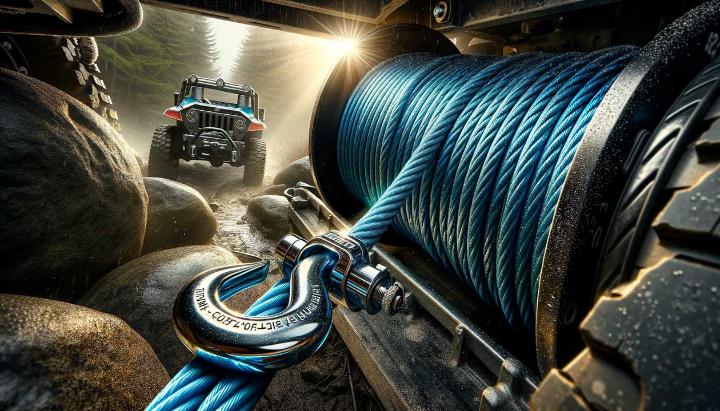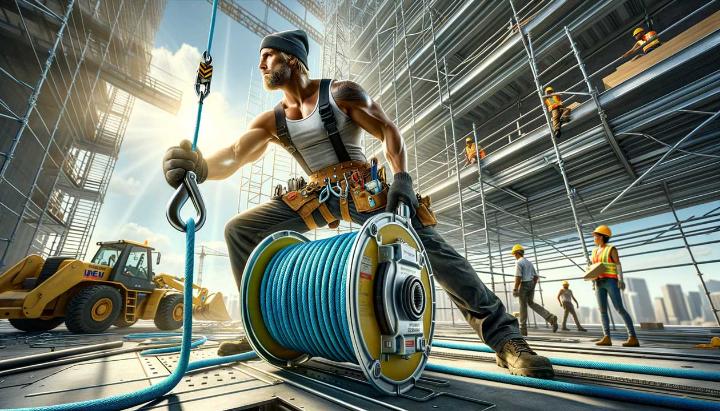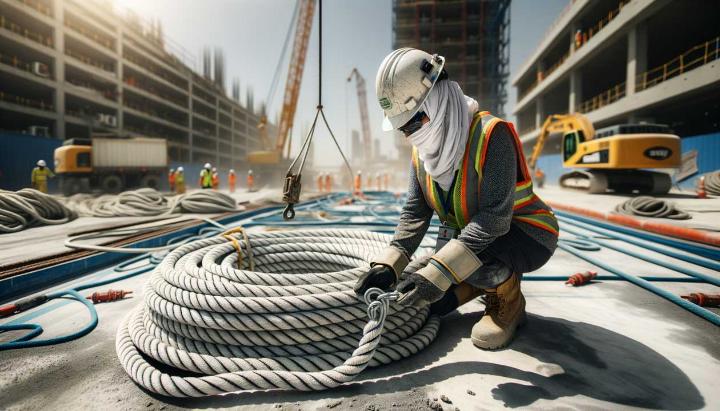Are you tired of heavy, cumbersome winch cables that are more trouble than they're worth? Imagine a world where lifting and winching operations are not only safer but also more efficient. Welcome to the revolutionary realm of ultra-high molecular weight polyethylene (UHMWPE) winch cables with hooks and lifting ropes.
In this ultimate guide, we'll explore why UHMWPE materials are rapidly becoming the go-to choice for winch cables with hooks and lifting ropes across various industries. From off-road enthusiasts to marine operators, professionals are discovering the game-changing benefits of this innovative material.
Get ready to dive into the world of UHMWPE and learn how it's transforming the landscape of lifting and winching operations. Whether you're a seasoned pro or new to the field, this guide will equip you with the knowledge to make informed decisions about your next winch cable with hook or lifting rope with hook purchase.
So, buckle up and prepare to discover why UHMWPE might just be the solution you've been searching for. Trust us, by the end of this guide, you'll be wondering how you ever managed without it.
UHMWPE Winch Cables: Superior Performance for Heavy-Duty Applications
Have you ever found yourself in a sticky situation, desperately needing a reliable winch cable to pull you out of trouble? Well, let me introduce you to the game-changer in the world of winching: UHMWPE winch cables.
UHMWPE, or Ultra-High Molecular Weight Polyethylene, is a synthetic material that's revolutionising the winching industry. These cables are quickly becoming the go-to choice for off-road enthusiasts, marine operators, and industrial professionals alike. But what makes them so special?
Advantages of UHMWPE Over Traditional Steel Cables
Picture this: you're out on a gruelling off-road adventure, and your trusty 4x4 gets bogged down in thick mud. You reach for your winch, but instead of the heavy, cumbersome steel cable you're used to, you find a lightweight, flexible UHMWPE rope. The difference is night and day.
- Lightweight powerhouse: UHMWPE cables are up to 10 times lighter than steel cables of the same strength. This means less strain on your winch motor and easier handling for you.
- Strength to weight ratio: Don't let its light weight fool you. UHMWPE cables boast an impressive strength-to-weight ratio, often outperforming steel in load capacity.
- Safety first: Unlike steel cables that can store energy and potentially snap back dangerously, UHMWPE ropes have minimal recoil, significantly reducing the risk of injury.
- Flexibility and durability: These synthetic ropes are incredibly flexible, making them less prone to kinking or bird-caging. They're also highly resistant to abrasion, UV radiation, and chemicals.

Comparing UHMWPE and Dyneema for Winch Line Performance
Now, you might be wondering, "What's the deal with Dyneema? Is it the same as UHMWPE?" Great question! Dyneema is actually a brand name for a specific type of UHMWPE fiber. It's like how all tissues might be called Kleenex, even if they're not that specific brand.
Both UHMWPE and Dyneema offer similar benefits:
- High strength: These materials can handle heavy loads with ease.
- Low stretch: Unlike nylon ropes, UHMWPE and Dyneema have minimal stretch, providing more precise control during winching operations.
- Floatation: Both materials float on water, making them ideal for marine applications.
When choosing between UHMWPE and Dyneema for your winch line, consider your specific needs and budget. Dyneema is often considered a premium option, but many generic UHMWPE ropes offer comparable performance at a lower cost.
Remember, whether you're tackling tough terrains or handling heavy loads, UHMWPE winch cables offer a winning combination of strength, safety, and ease of use. So, next time you're in the market for a replacement winch cable with hook, consider making the switch to UHMWPE. Your winching experience will never be the same!
Factors to Consider When Choosing a Replacement Winch Cable with Hook
Choosing the right replacement winch cable with hook can be the difference between a successful recovery and a potential disaster. As an off-road enthusiast who's been in more than a few sticky situations, I've learned that selecting the proper winch cable is crucial for both safety and performance. Let's dive into the key factors you need to consider when making this important decision.
Material Options: Steel vs Synthetic Winch Rope
The age-old debate of steel vs synthetic winch rope continues to spark passionate discussions around campfires and in off-road forums. Both materials have their strengths, but synthetic ropes, particularly those made from ultra-high molecular weight polyethylene (UHMWPE), are gaining popularity for good reasons.
- Steel wire rope: Durable and heat-resistant, but heavy and prone to storing energy when under tension.
- Synthetic winch rope: Lightweight, flexible, and with a higher breaking strength than steel of the same diameter.
In my experience, synthetic ropes like UHMWPE offer a fantastic balance of strength and usability. They're much easier on the hands and significantly reduce the risk of injury if the line breaks under tension.
Determining the Right Size and Strength for Your Winch
Selecting the correct size and strength for your winch cable is crucial. You need to consider both the breaking strength and the working load limit. Here's a simple guide to help you make the right choice:
- Determine your vehicle's gross vehicle weight (GVW)
- Multiply the GVW by 1.5 to get the minimum breaking strength required
- Choose a winch cable with a breaking strength that exceeds this number
Remember, the working load limit is typically about one-third of the breaking strength. Always err on the side of caution and choose a cable with higher ratings than you think you'll need.
Pro Tip: A safety factor of 1.5:1 to 2:1 is recommended for winch lines. This means your winch cable's breaking strength should be at least 1.5 to 2 times your vehicle's weight.
Hook Type and Size: Matching Your Lifting Requirements
The hook on your winch cable is just as important as the cable itself. Consider these factors when choosing a hook:
- Load capacity: Ensure the hook can handle the same load as your winch cable
- Throat opening: Choose a size that accommodates your most common recovery points
- Safety latch: A must-have feature to prevent accidental disengagement
I once made the mistake of using a hook that was too small for my recovery points, and let me tell you, it's not a situation you want to find yourself in when you're stuck in the mud!
Additional Features: Anti-Twist and Anti-Rotation Properties
When it comes to winch cables, especially synthetic ropes, anti-twist and anti-rotation properties can be game-changers. These features help prevent the rope from spinning or kinking under load, which can significantly reduce its strength and lifespan.
In my years of off-roading, I've found that cables with these properties are much easier to handle and last longer. They're especially useful when you're working in tight spaces or at odd angles.

Remember, choosing the right winch cable with hook is about balancing strength, durability, and usability. Consider your specific needs, the environments you'll be operating in, and don't be afraid to invest in quality. After all, when you're stuck in a tough spot, your winch cable might be your only way out!
Benefits of UHMWPE Lifting Rope with Hook
As someone who's spent years in the rigging industry, I've seen firsthand the evolution of lifting equipment. And let me tell you, UHMWPE lifting ropes with hooks are a game-changer. But what makes them so special? Let's dive in and explore the incredible advantages these high-tech ropes bring to the table.
Superior Strength and Lightweight Properties
Picture this: you're on a job site, and you've got a heavy load to lift. With traditional steel wire ropes, you'd be bracing yourself for a workout. But with UHMWPE lifting ropes, it's a whole different ballgame.
- Incredible strength-to-weight ratio: UHMWPE ropes are up to 85% lighter than steel wire ropes of equivalent strength. This means you can handle heavier loads without breaking a sweat.
- Reduced operator fatigue: The lightweight nature of these ropes makes them a dream to handle. I remember a colleague once joking that using UHMWPE ropes felt like he'd suddenly gained superhuman strength!
- Improved efficiency: With less weight to maneuver, you can work faster and more precisely, boosting overall productivity on the job.

Durability and Resistance to Environmental Factors
Working in harsh environments? UHMWPE lifting ropes have got you covered. Their resilience in challenging conditions is truly remarkable.
- Exceptional abrasion resistance: These ropes can take a beating and keep on ticking. I've seen UHMWPE ropes outlast steel wire ropes by a significant margin in abrasive conditions.
- Chemical and UV resistance: Whether you're working with corrosive materials or under the scorching sun, UHMWPE ropes maintain their integrity.
- Moisture resistance: Unlike steel ropes that can rust, UHMWPE ropes shrug off moisture like it's nothing. This makes them ideal for marine and offshore applications.
I once worked on an offshore project where we switched to UHMWPE ropes. The difference in durability was night and day compared to our old steel wire ropes. Even after months of exposure to salt water and harsh weather, the UHMWPE ropes looked almost brand new.
Improved Safety and Efficiency in Lifting Operations
When it comes to lifting operations, safety is paramount. UHMWPE lifting ropes with hooks offer some significant safety advantages that can give you peace of mind on the job.
- Minimal recoil: In the unlikely event of a rope failure, UHMWPE ropes have minimal recoil, reducing the risk of injury to operators and bystanders.
- Excellent flexibility: These ropes can bend and flex without losing strength, making them ideal for complex rigging setups.
- Floatation properties: Working near water? UHMWPE ropes float, making them easier to retrieve and reducing the risk of accidents.
Have you ever tried to maneuver a heavy steel wire rope around tight corners or over obstacles? It can be a real challenge. With UHMWPE ropes, those tricky rigging setups become much more manageable, saving you time and reducing the risk of accidents.
Pro Tip: When choosing a UHMWPE lifting rope with hook, always check the working load limit (WLL) and ensure it's appropriate for your specific application. Remember, safety should always be your top priority!
In conclusion, UHMWPE lifting ropes with hooks offer a winning combination of strength, durability, and safety that's hard to beat. Whether you're working in construction, marine environments, or any other industry that requires heavy lifting, these high-tech ropes can revolutionize your operations. So, next time you're in the market for a lifting solution, why not give UHMWPE a try? Your back (and your workers) will thank you!
Maintenance and Inspection of UHMWPE Winch Cables and Lifting Ropes
As someone who's spent years working with various types of winch cables and lifting ropes, I can't stress enough how crucial proper maintenance and regular inspection are for UHMWPE (Ultra-High Molecular Weight Polyethylene) equipment. These high-tech ropes have revolutionised the industry, but they require a different approach to care compared to traditional steel cables. Let's dive into the nitty-gritty of keeping your UHMWPE winch cables and lifting ropes in top-notch condition.
Proper Cleaning and Care Techniques
Picture this: you've just finished a gruelling day of off-roading, and your UHMWPE winch cable is caked with mud and grime. What's your next move? Here's a step-by-step guide to get your rope clean and ready for its next adventure:
- Rinse the rope with fresh water to remove loose dirt and debris.
- Mix a mild detergent with warm water in a bucket.
- Gently scrub the rope with a soft-bristled brush, working the soapy solution into the fibres.
- Rinse thoroughly with clean water until all soap residue is gone.
- Allow the rope to air dry completely before storing or re-spooling.
Remember, harsh chemicals are a big no-no for UHMWPE ropes. Stick to mild detergents to preserve the rope's integrity.
Pro Tip: After cleaning, always re-spool your winch cable under tension. This prevents loose wraps and potential damage during future use.
Visual Inspection Guidelines
Regular visual inspections are your first line of defence against potential rope failure. Here's what to look out for:
- Cut strands: Run your hands along the rope, feeling for any nicks or cuts in the fibres.
- Fraying: Check for loose or unravelling fibres, especially near the ends and around splices.
- Abrasion: Look for areas where the rope appears flattened or has a fuzzy texture.
- Heat damage: Inspect for any glossy or melted sections, which indicate exposure to excessive heat.
I once had a close call when I missed a small cut during inspection. The rope failed during a critical lift, thankfully without injury. Since then, I've become almost obsessive about thorough visual checks before each use.

Replacement Criteria and Frequency
Even with the best care, UHMWPE ropes don't last forever. Here's when it's time to retire your rope:
- Age: Replace synthetic winch ropes every two to three years with regular use.
- Visible damage: Any cuts, severe abrasion, or heat damage warrant immediate replacement.
- Loss of flexibility: If the rope feels stiff or doesn't bend easily, it's time for a new one.
- Excessive use: Heavy-duty applications may require more frequent replacements.
Don't push your luck with an old or damaged rope. The cost of replacement is nothing compared to the potential safety risks.
Remember, maintaining your UHMWPE winch cables and lifting ropes isn't just about prolonging their life – it's about ensuring your safety and the safety of those around you. By following these guidelines and staying vigilant, you'll get the most out of your high-performance ropes while keeping your operations safe and efficient.
When it comes to finding a reliable winch cable with hook, the benefits of ultra-high molecular weight polyethylene (UHMWPE) materials cannot be overstated. These cables offer an impressive strength-to-weight ratio, exceptional durability, low stretch, and high load capacity, making them ideal for heavy-duty applications. Choosing the right replacement winch cable with hook involves considering the required breaking strength, diameter, length, and additional features like anti-twist properties. UHMWPE lifting rope with hook brings added advantages such as reduced operator fatigue, enhanced flexibility, and improved safety due to minimal recoil. Regular maintenance and inspection are critical to extending the lifespan and ensuring safe operations. Ultimately, UHMWPE materials set a new standard for winch and lifting ropes, making them indispensable for various industries.
Get a Custom Winch Cable Solution for Your Needs
Fill out the form above to get in touch with our specialists and discover the perfect lifting rope with hook tailored to your requirements. We are here to assist with any inquiries or needs you may have, ensuring you select the best product for your operations.